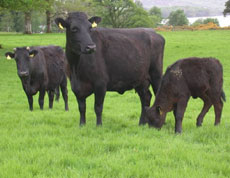Cattle have been
important in Irish culture and society since the earliest times,
their ownership a mark of wealth and importance. Archeogogical evidence
indicates that cattle appeared in Ireland sometime around 3,500
BC, it is thought that these early cattle were similar to the present
day Kerry cattle, which are black.
Cattle raids seem to have been almost a way
of life for many if not all tribes, figuring prominently in folklore,
the Cattle raid of Cooley being the prime example. The Black Pigs
Dyke an extensive earthworks beginning in southern Ulster and stretching
discontinuously as far as Connacht, radio carbon dating places wood
used in its construction at around 390-370 BC, it is thought its
main use was to combat cattle raids. The dyke derives its name from
Irish fokelore which attributed the dyle as the work of a huge black
boar.
Cattle were first domesticated in Greece
about 6000 BC pigs in Russia a  little
earlier, neither came to Ireland with the first settlers. The prospect
of milk and meat from the cattle and the fast maturing qualities
of the pig caused the use of these animals to spread rapidly across
Europe, possibly as a result of both trade and war. The staple diet
of the Irish was grain and no doubt oxen were soon pressed into
service to plough the land. little
earlier, neither came to Ireland with the first settlers. The prospect
of milk and meat from the cattle and the fast maturing qualities
of the pig caused the use of these animals to spread rapidly across
Europe, possibly as a result of both trade and war. The staple diet
of the Irish was grain and no doubt oxen were soon pressed into
service to plough the land.
Horses have been known in Western Europe
since the end of the last ice age, the concept of riding or using
the horse for draught purposes only occurred to man about four thousand
years ago on the Eurasian steppes, and spread slowly to the rest
of the world, previously they had just been eaten. By the time the
Celts arrived in Ireland  the
horse was well established, whether the horse was here prior to
their arrival is unclear. We do know that they made extensive use
of the horse, particularly in warfare using it to pull their chariots,
it also figured prominently in their culture and folklore. the
horse was well established, whether the horse was here prior to
their arrival is unclear. We do know that they made extensive use
of the horse, particularly in warfare using it to pull their chariots,
it also figured prominently in their culture and folklore.
The pig evolved in the forests, it is happiest
there grubbing a living from the forest floor eating acorns nuts
and roots. The Celts no more predisposed to unnecessary work than
anyone else, probably soon discovered they could turn a herd of
pigs into a forest tended by a swineherd, and produce some tasty
bacon and pork with little effort. This practice however in the
long term must have contributed significantly to deforestation the
pigs consuming the seeds and saplings. As time passed the old trees
died and with nothing to take their place, the forest became grass
or scrub land. |